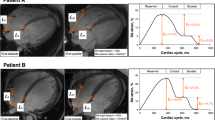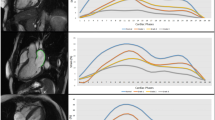Abstract
Cardiac magnetic resonance (CMR) can provide a multi-parametric evaluation of left atrial (LA) size and function. A complete CMR-based LA assessment might improve the risk stratification of patients with non-ischemic dilated cardiomyopathy (DCM). We performed a comprehensive CMR-based evaluation of LA size and function, in order to assess the prognostic impact of specific LA parameters in DCM. Secondary analysis of a prospective registry (UHSM-CMR study, NCT02326324) including 648 consecutive patients with DCM and CMR evaluation of LA area and LA length. Of these, 456 had complete LA assessment covering reservoir, conduit and booster pump function and including LA reservoir strain evaluated with feature tracking. The heart failure (HF) endpoint included HF hospitalizations, HF death and heart transplant. The arrhythmic endpoint included ventricular arrhythmias (VA) (sustained or treated by implantable defibrillator) and sudden death (SD). At median follow-up of 23 months, 34 patients reached the HF endpoint; in a multivariable model including NYHA class and LVEF, LA length had incremental predictive value. LA length ≥ 69 mm was the best cut-off to predict HF events (adjusted HR 2.3, p = 0.03). Among the 456 patients with comprehensive LA assessment, only LA length was independently associated with the HF endpoint after adjusting for LVEF and NYHA class. By contrast, no LA parameter independently predicted the arrhythmic risk. In DCM patients, LA length is an independent predictor of HF events, showing stronger association than other more complex parameters of LA function. No atrial parameter predicts the risk of VA and SD.





Similar content being viewed by others
Data Availability
The dataset is contained within the UHSM-redCAP database as part of the UHSM-CMR study. The datasets used and/or analysed during the current study may be available from the corresponding author on reasonable request.
Abbreviations
- AF:
-
atrial fibrillation
- AIC:
-
Akaike information criterion
- CMR(i):
-
cardiac magnetic resonance (imaging)
- DCM:
-
dilated cardiomyopathy
- ECV:
-
extracellular volume
- EF:
-
ejection fraction
- EPR:
-
electronic patient records
- FT:
-
feature tracking
- HF:
-
heart failure
- HFH:
-
heart failure hospitalisation
- ICD:
-
implantable cardioverter defibrillator
- LA:
-
left atrium
- LGE:
-
late gadolinium enhancement
- LV:
-
left ventricle
- ROC:
-
receiver operator curves
- SAE:
-
significant arrhythmic event
- SD:
-
sudden death
- SSFP:
-
steady state free precession
- VA:
-
ventricular arrhythmia
References
Triposkiadis F et al (1994) Left atrial myopathy in idiopathic dilated cardiomyopathy. Am Heart J 128(2):308–315
Rossi A et al (2009) Independent relationship of left atrial size and mortality in patients with Heart Failure: an individual patient meta-analysis of longitudinal data (MeRGE Heart Failure). Eur J Heart Fail 11(10):929–936
Rossi A et al (2002) Determinants and prognostic value of left atrial volume in patients with dilated cardiomyopathy. J Am Coll Cardiol 40(8):1425
Modena MG et al (1997) Left atrial size is the major predictor of cardiac death and overall clinical outcome in patients with dilated cardiomyopathy: a long-term follow-up study. Clin Cardiol 20(6):553–560
Negishi K et al (2016) Left atrial booster pump function is an Independent predictor of subsequent life-threatening ventricular arrhythmias in non-ischaemic cardiomyopathy. Eur Heart J Cardiovasc Imaging 17(10):1153–1160
Modin D et al (2019) Prognostic Value of Left Atrial Functional measures in Heart Failure with reduced ejection fraction. J Card Fail 25(2):87–96
Kowallick JT et al (2014) Quantification of left atrial strain and strain rate using Cardiovascular magnetic resonance myocardial feature tracking: a feasibility study. J Cardiovasc Magn Reson 16:60
Truong VT et al (2020) Normal left atrial strain and strain rate using cardiac magnetic resonance feature tracking in healthy volunteers. Eur Heart J Cardiovasc Imaging 21(4):446–453
Li Y et al (2022) Left atrial function predicts Outcome in Dilated Cardiomyopathy: fast Long-Axis strain analysis derived from MRI. Radiology 302(1):72–81
Raafs AG et al (2022) Left atrial strain has Superior Prognostic Value to ventricular function and delayed-enhancement in dilated cardiomyopathy. JACC Cardiovasc Imaging 15(6):1015–1026
Maceira AM et al (2006) Normalized left ventricular systolic and diastolic function by steady state free precession cardiovascular magnetic resonance. J Cardiovasc Magn Reson 8(3):417–426
Di Marco A et al (2021) Improved risk stratification for ventricular arrhythmias and sudden death in patients with nonischemic dilated cardiomyopathy. J Am Coll Cardiol 77(23):2890–2905
Kramer CM et al (2013) Standardized cardiovascular magnetic resonance (CMR) protocols 2013 update. J Cardiovasc Magn Reson 15:91
Miller CA et al (2013) Quantification of left ventricular indices from SSFP cine imaging: impact of real-world variability in analysis methodology and utility of geometric modeling. J Magn Reson Imaging 37(5):1213–1222
Hudsmith LE et al (2005) Normal human left and right ventricular and left atrial dimensions using steady state free precession magnetic resonance imaging. J Cardiovasc Magn Reson 7(5):775–782
H., A., A new look at the statistical model identification. IEEE Trans Autom Control, 1974(6): p. 716–723
Urbich M et al (2020) A systematic review of medical costs Associated with Heart Failure in the USA (2014–2020). PharmacoEconomics 38(11):1219–1236
Jong P et al (2002) Prognosis and determinants of survival in patients newly hospitalized for Heart Failure: a population-based study. Arch Intern Med 162(15):1689–1694
Gulati A et al (2013) Clinical utility and prognostic value of left atrial volume assessment by cardiovascular magnetic resonance in non-ischaemic dilated cardiomyopathy. Eur J Heart Fail 15(6):660–670
Yazaki M et al (2021) Clinical significance of left atrial geometry in dilated cardiomyopathy patients: a cardiovascular magnetic resonance study. Clin Cardiol 44(2):222–229
Álvarez-García J et al (2015) A simple validated method for predicting the risk of hospitalization for worsening of Heart Failure in ambulatory patients: the Redin-SCORE. Eur J Heart Fail 17(8):818–827
Habibi M et al (2014) Association of CMR-measured LA function with Heart Failure development: results from the MESA study. JACC Cardiovasc Imaging 7(6):570–579
Chirinos JA et al (2018) Left atrial phasic function by Cardiac magnetic resonance feature tracking is a strong predictor of Incident Cardiovascular events. Circ Cardiovasc Imaging 11(12):e007512
Nistri S et al (2006) Prognostic significance of left atrial size in patients with hypertrophic cardiomyopathy (from the Italian Registry for hypertrophic cardiomyopathy). Am J Cardiol 98(7):960–965
Spirito P et al (2009) Syncope and risk of sudden death in hypertrophic cardiomyopathy. Circulation 119(13):1703–1710
O’Mahony C et al (2014) A novel clinical risk prediction model for Sudden Cardiac Death in hypertrophic cardiomyopathy (HCM risk-SCD). Eur Heart J 35(30):2010–2020
Di Marco A et al (2017) Late Gadolinium Enhancement and the risk for ventricular arrhythmias or sudden death in dilated cardiomyopathy: systematic review and Meta-analysis. JACC Heart Fail 5(1):28–38
Desai AS et al (2004) Implantable defibrillators for the prevention of mortality in patients with nonischemic cardiomyopathy: a meta-analysis of randomized controlled trials. JAMA 292(23):2874–2879
Beggs SAS et al (2018) Non-ischaemic cardiomyopathy, sudden death and implantable defibrillators: a review and meta-analysis. Heart 104(2):144–150
Puntmann VO et al (2016) T1-Mapping and outcome in nonischemic cardiomyopathy: all-cause mortality and Heart Failure. JACC Cardiovasc Imaging 9(1):40–50
Acknowledgements
Not applicable.
Funding
Dr Brown was in receipt of a joint Alliance Medical + UHSM Fellowship Salary support grant. Drs Miller and Schmitt received a restricted grant by Guerbet in support of the UHSM CMR study (NCT02326324).
Author information
Authors and Affiliations
Contributions
PB/AdiM/MS conceived, wrote and revised the manuscript. PB/ZT/JB/AR contributed to data collection. AdiM conducted statistical analysis. AdiM/MS/CM/GN supervised the project. All authors reviewed and approved the final manuscript.
Corresponding authors
Ethics declarations
Ethics approval and consent to participate
Participants were recruited from the UHSM-CMR Study, National Clinical Trials number 02326324, and received appropriate ethical approval (IRAS id is: 159694 and REC reference: 14/NW/1165). All patients gave written, informed consent for participation.
Consent for publication
All patients gave written, informed consent for publication.
Competing interests
The authors declare that they have no competing interests.
Additional information
Publisher’s Note
Springer Nature remains neutral with regard to jurisdictional claims in published maps and institutional affiliations.
Electronic supplementary material
Below is the link to the electronic supplementary material.
Rights and permissions
Springer Nature or its licensor (e.g. a society or other partner) holds exclusive rights to this article under a publishing agreement with the author(s) or other rightsholder(s); author self-archiving of the accepted manuscript version of this article is solely governed by the terms of such publishing agreement and applicable law.
About this article
Cite this article
Brown, P.F., Di Marco, A., Tsoumani, Z. et al. Predictive value of a comprehensive atrial assessment with cardiac magnetic resonance in non-ischemic cardiomyopathy: keep it simple. Int J Cardiovasc Imaging 40, 557–567 (2024). https://doi.org/10.1007/s10554-023-03024-4
Received:
Accepted:
Published:
Issue Date:
DOI: https://doi.org/10.1007/s10554-023-03024-4




